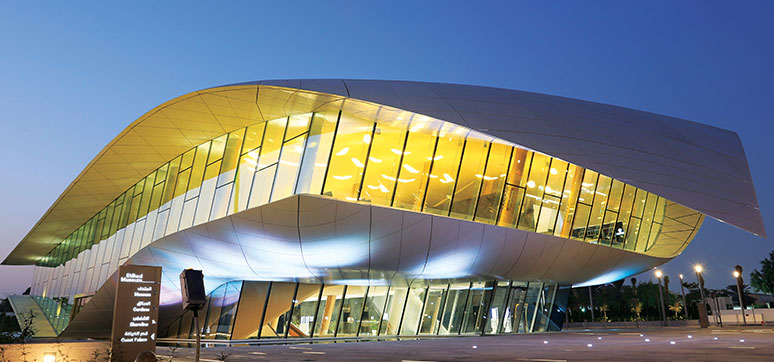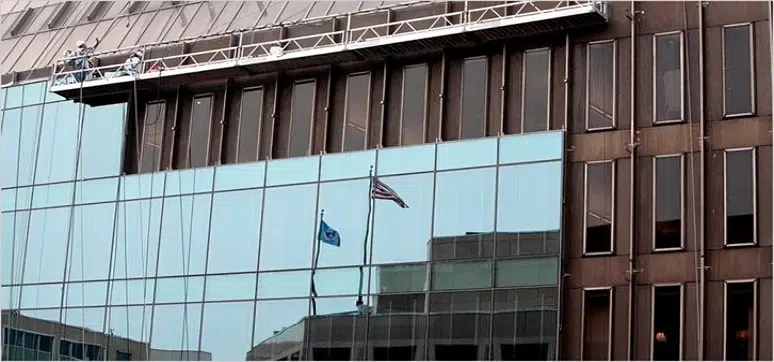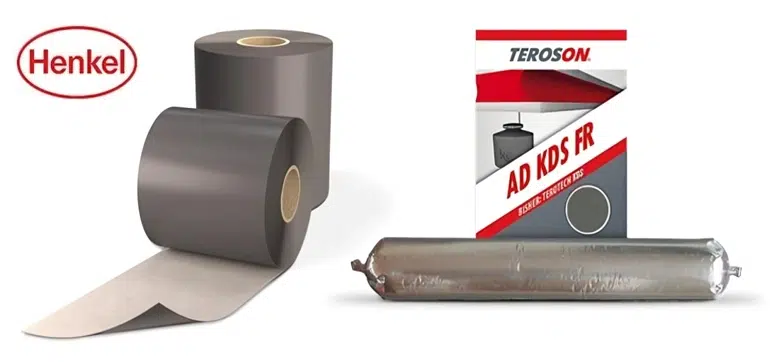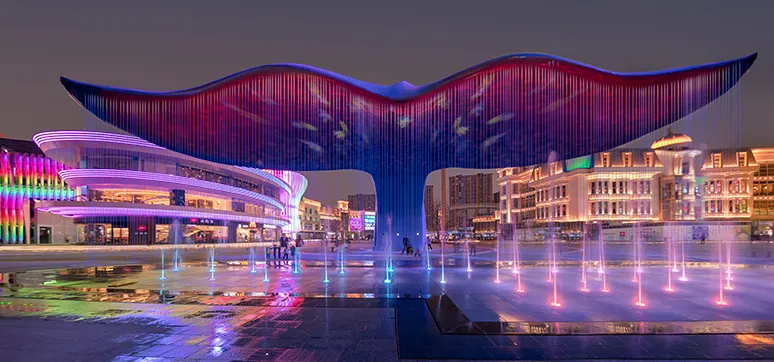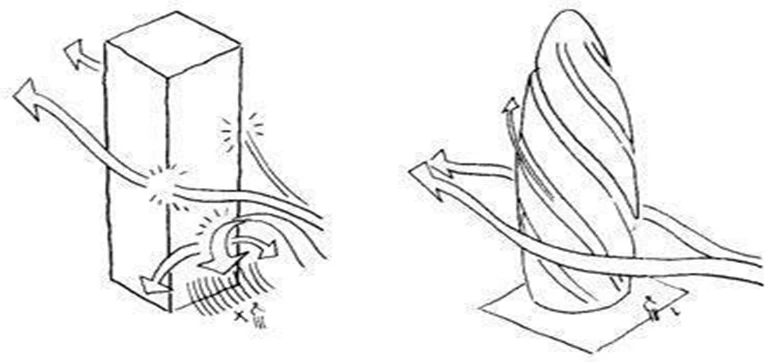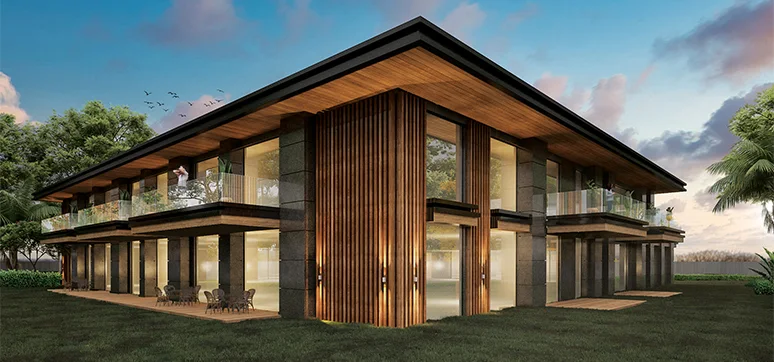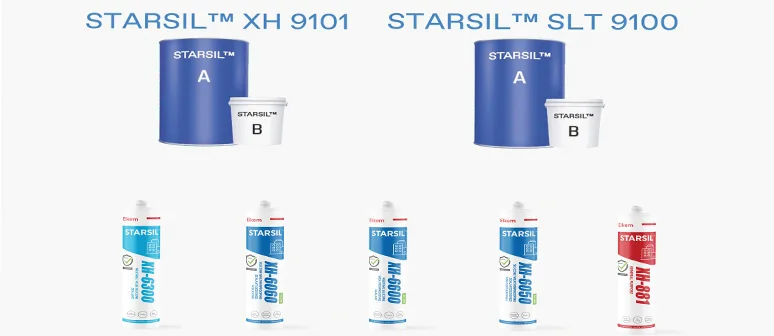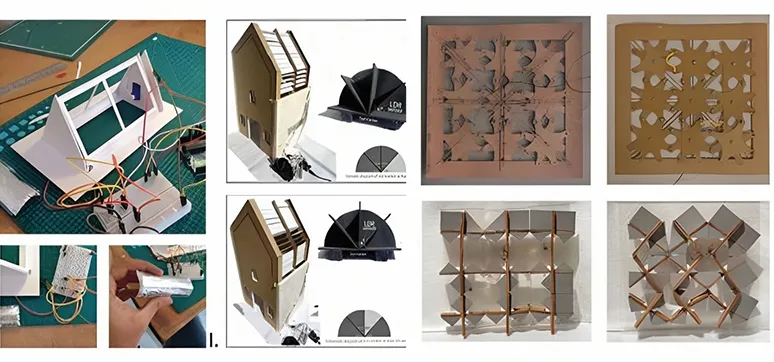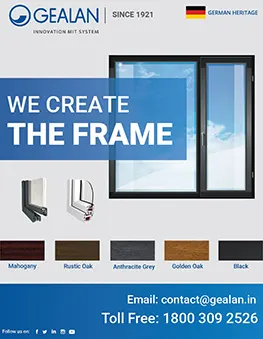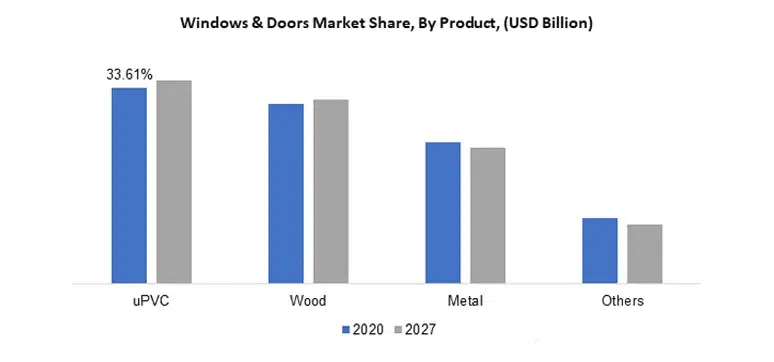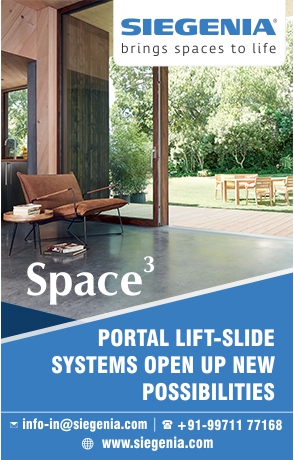Glass Facade – A Boon for the Fenestration Industry
By:
Glass is one of the oldest and most popular material in building construction. Over the years, it has emerged as one of the widely used facade materials around the world. Glass when used as a facade material, makes the building look more beautiful. One of the most important benefits of glass is that it allows natural light to enter the building, thus saving the electricity costs. Glass Facade also offers extraordinary flexibility, which makes it the most preferred choice amongst the architects, builders and consultants.
In this Article, the experts have given their opinions on how glass is revolutionizing the building industry in the Middle East. Through this article, you will also get to know about the new technological trends in the glass facade and how they benefit the buildings in the region.
Demand for glass facades in Building Envelope
Over the centuries, the glass has evolved dramatically. For years, the glass remained a hardly available fragile material with poor optical and energy properties, and limited ability to provide enough light into the buildings.
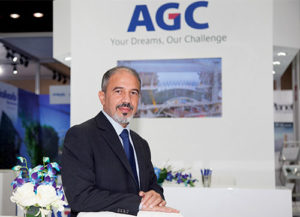
Contemporary architectural glass turned into an eco-friendly, chemically durable and robust construction material, which brings us light and protects from the elements, ensuring high levels of solar control, thermal insulation, safety and security, comfort when it comes to sound insulation, daylight and glare control and other aspects. Glass with its main unique property – transparency – allows architects and designers to unleash their creativity and provide a better harmony between the nature and the human being.
Moreover, glass facade look visually attractive during both daytime and nighttime, says Ahmed Baker, Sales & Marketing Manager, AGC Obeikan Glass.

According to Alain Garnier, Manager, Sales & Business Development Middle East, Saint-Gobain SageGlass, there is a strong trend to increase the glass facade and glazing surface in the building envelope, especially in the Middle East. Architects and designers really love this material because of its great architectural and aesthetical properties.
Glass facade is the perfect solution to bring natural daylight into the building and allow the building occupants to enjoy the view to the outside. As we spend most of our time in buildings, it is very important to have the access to natural light. The biophilic design responds to this trend. According to the World Green Building Council, there is “overwhelming evidence” that demonstrates the design of a building impacts the health and well-being of its occupants.
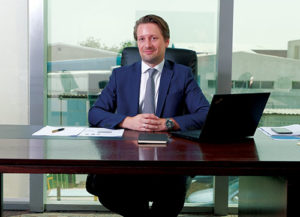
In particular, day lighting and views to outdoors have been the subject of a large body of research, revealing their key role in creating more comfortable and healthy spaces. While glazing constitutes the ideal material for bringing daylight and connection to the outside indoors, they can also have unwanted counter effects such as overheating and glare, thus impacting both the energy and comfort performances of the building.
The demand for glass is somewhat similar to recent years. However, architects and consultants demand better performing glazing and more complex compositions – and this increases the energy efficiency of buildings and satisfies today’s stricter regulations, says Julian J. Pollmann, Special Products Sales & Marketing Manager, Emirates Glass LLC.
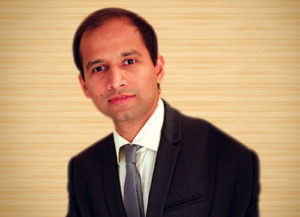
Firoz Kachwala, Director,Future Architectural Glass LLC opines that glass is an ideal choice of material for developers to clad their building façade, being a maintenance-free material, easy to install, enabling fast construction and creating aesthetically appealing building skins. The market is buoyant today, in the whole region a multitude of projects are being executed right now. In the UAE in particular, there are a lot of projects that are in the tender or construction stage, which aims to be finalized by 2020. A major challenge is, therefore, completing the projects in time for the Expo 2020 Dubai.
Choice Of Glass For Windows For Effective Fenestration
Baker believes that in addition to the colour, safety and comfort related factors such as sound insulation, thermal insulation and glare control, are important when it comes to choosing the glass. We see a lot of improvement in the industry in terms of implementation of local regulations, and particularly, solar control & thermal insulation requirements.
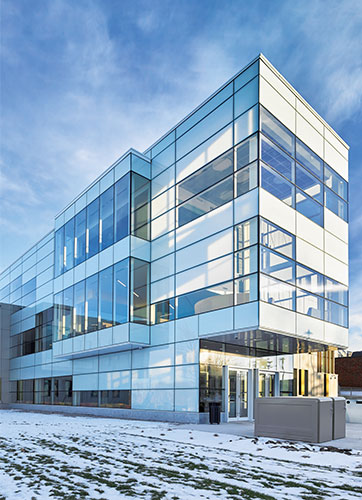
The right amount of light and heat passing through the window is crucial to the comfort of the building occupants, therefore it is essential to choose the high performance glass solutions. Such innovative climate control solutions help to minimise energy costs, making it the right choice for effective fenestration.
Garnier notes that the best choice of glazing is the one that offers the best solar control and insulation performances. There are great high performance glazing in the market that can fulfill these requirements and the best solution is dynamic electrochromic glass. It offers an environmentally friendly and energy-efficient alternative to blinds or shades, and provides reliable indoor comfort, whilst at the same time ensuring the long-term sustainability of the building.
Dynamic electrochromic glass can be silently tinted and made fully clear again either automatically or manually at the touch of a button, using an app on a smart phone or tablet, or even voice activated. The dynamic electrochromic glass has an unsurpassed optical and solar performance, providing significant energy savings, thermal comfort at 1% visible light transmission, glares control and all without losing the view to the outside. When dark, SageGlass blocks 99% of the light and 95% of the heat.
According to Pollmann, the choice of glass has always been a much discussed topic and effectiveness depends mainly on the application and the geography of the building. While the industry is looking for high light and heat transmission and best possible insulation to passively heat buildings in Central Europe, particularly during winter, here in the Middle East we have to focus mainly on heat rejection at reasonably high light transmission, or in other words high selectivity. The most effective fenestration will match the application and design intent, and is best chosen together with the competent glass processor.
According to Kachwala, glass, as a material, has evolved over the years since its invention 5000 years back. Over the years, the usage of glass in a building has increased and has driven up the demand for higher energy efficiencies on the fenestration, and architects want more to achieve better window glazing standards.
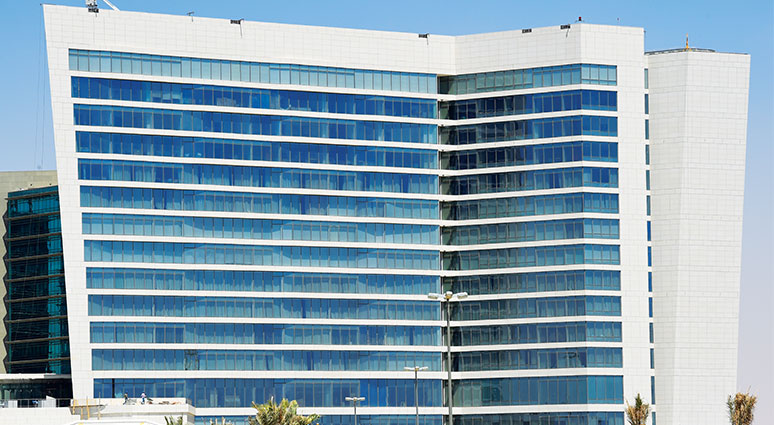 Hilton Riyadh Hotel Residences, by Omrania Associates, KSA
Hilton Riyadh Hotel Residences, by Omrania Associates, KSA
Especially in the Middle East, a high level of insulation is needed on the fenestration to maintain comfortable interior spaces and work environment. This has resulted in increasing use of high-performance coatings on the glass makeup that provide Shading Coefficient (SC) of 0.25 or lower while allowing for light transmittance of 40% or higher. Local and international coated glass manufacturers have upped their game and introduced high-performance double and triple silver Low-E coatings to keep up with the building code regulations.
He adds, that high performance glass has become the choice of architects/developers for effective glazed façades bringing comfort to the occupants and enhancing the value of their asset.
Limitations Complete Glass Walls, Considering UAE Climatic Conditions
According to Baker, despite of the hot climate in the UAE, the limitations of having complete glass walls are minimised due to locally available innovative sputter coating technology. The sputter-coated glass allows engineers to use glass in a large scale for high-rise towers.
Apart from great aesthetics, complete glass walls are able to provide safety and comfort for buildings’ occupants. We can see it in the UAE market a lot – fully glazed high rise towers without compromising on the energy saving and comfort. Glass is very friendly to any design and can be used as an independent material or in combination with any cladding material. The only limit is our creativity.
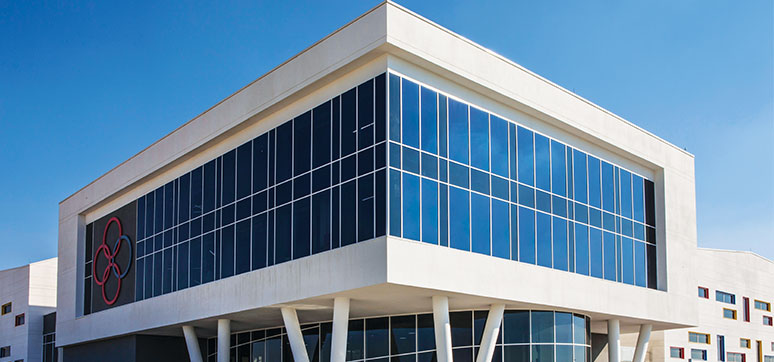 Façade at the Swiss International School in Dubai, UAE
Façade at the Swiss International School in Dubai, UAE
Garnier says, in the UAE climate conditions, the main issues for full glass facade is heat and glare. One challenge is that heat and glare are coming together with the natural light. It is important to use a solution that can help control the amount of light, heat and glare into space. Reducing heat and glare is a key target in the Middle East region.
In Glass Facade, especially the dynamic glass, can offer a very high level of performances that can match the highest level of performance of claddings. Views provide a psychological effect through the connection with other groups of people and the surroundings while in a safe space. Views allow the eyes to adjust, re-focus and relax, and so reduce eye strain and induced fatigue.
It provides a link with daylight that affects the physical health of the human body through regulating circadian rhythms. An attractive view, whether of a built or natural scene, might promote cognitive, effective, and physiological restoration. Although blinds and shades could help minimise heat gain and glare, they would obstruct the view. Blinds and shades would also attract dust and require constant cleaning.
Pollmann says, from the perspective of the glazing manufacturer and processor, there are no limitations, and in fact, we would wish for a lot more glass being used in buildings. Sure, other non-transparent materials such as cladding have a less direct transmission, which reduces the cooling loads, but at the same time, they limit the amount of natural light within the space.
Kachwala states, glass is a maintenance free construction material that is the material of choice for developers. Architects also prefer the use of glass on façades as it allows them to create well-lit interior spaces and provide occupants a visual connection to the outside world.
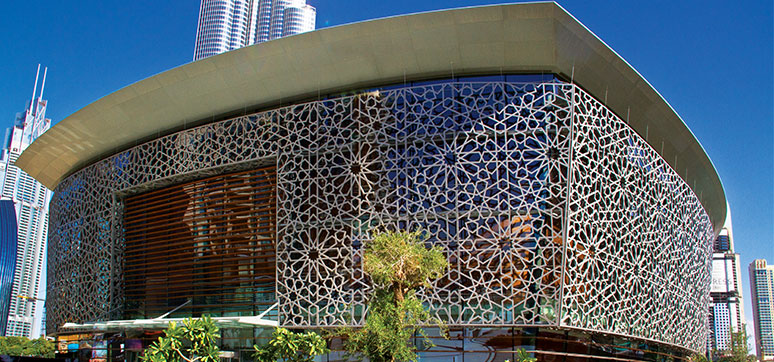 Opera House Dubai (Future Architectural Glass LLC)
Opera House Dubai (Future Architectural Glass LLC)
However, it needs to be used responsibly and specified as per the site conditions/ building code regulations. The Government of Dubai, along with DEWA and Dubai Municipality, has set fourth green building regulations and specifications that provide a guide for the usage of glazed elements on the fenestration. For example:
• If the total area of fenestration is 40% or less
than the SC should not exceed 0.4.
• If the total area of fenestration is 60% or more
then the SC should not exceed 0.25
Architects can find unique ways of incorporating other cladding materials like aluminum, terracotta, stone, composite panels, GFRC and others. Combining other cladding elements greatly enhances the aesthetics/functionality and complements the use of glass facade, he adds.
Use Of Glass For Contemporary Facade & Fenestration
Glass is one of the oldest man-made material used in the world. I see the glass as one of the most elegant materials used for modern building’s architecture, as it has been used since the 17th century for iconic historical buildings. Architects and specifiers love glass. The multifaceted functions and aesthetic properties of glass are incorporated into modern designs more often than almost any other material, says Baker.
According to Garnier, glass is a great material that offers a lot of design flexibility to architects and designers. As outlined before, there are no technical limitations in the use of glass and glazing for facades as it can be as performant or even more performant than blocks or claddings.
Electronically Tintable Glass, also known as Electrochromic (EC) Glass, allows the building façade to become dynamic, changing the transmission of the solar heat and light in response to the exterior environment and the needs of the building’s occupants, while always remaining transparent. It thus offers an innovative and elegant solution to address the design challenge of creating both energy efficient and comfortable well daylight spaces.
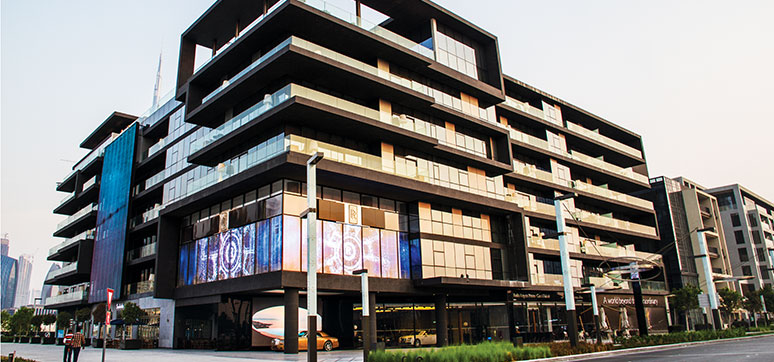 Citywalk, Dubai (Future Architectural Glass LLC)
Citywalk, Dubai (Future Architectural Glass LLC)
New developments in the EC technology show that dynamic glass allows to achieve sustainable design goals, without compromising on aesthetic choices.
Pollmann opines that the R&D of glass and coatings allow us to have exciting architecture and uniquely shaped buildings, while still keeping most of the heat outside. Only through the combined usage of target materials with high infrared-reflectance and newly developed metal-oxides to enhance performance as well as the durability of the coating, it is possible to create sustainable and comfortable living and working places while minimising energy usage.
Kachwala believes that although glass is in use for centuries, it has found its use extensively as a modern cladding material in the last few decades. Today, contemporary facades feel incomplete without effective use of glass on them. Bespoke specialty glass options are available in the industry that brings life to the building. While the inherent properties of glass, it adds tremendous aesthetic value to any space, specialty glass products redefine the boundaries of architectural design. Specialty glass producers offer a range of products that include energy-generating photovoltaic glass, vivid metallic mesh glass, amazing colour laminates and infinite possibilities with digital ceramic prints. Glass can also be combined with other cladding materials like terracotta/stone/composite panels to create bespoke Glass Facade and make a style statement.
Factors Affecting Solar Heat Gain
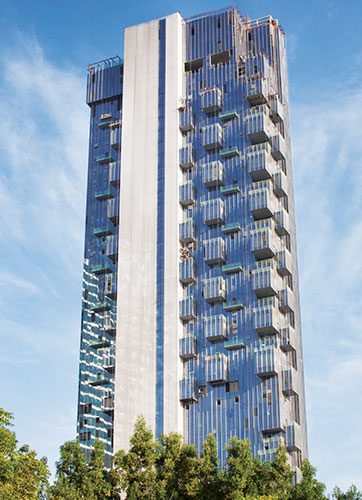
Solar heat through fenestration plays a major role in determining the thermal performance of any building. It is always a challenge to balance between the right amount of the light, glare and heat affecting the building HVC (heating, ventilation and air conditioning) systems.
Coated glass is one of the flexible materials, providing such balance, and is relevant to the different high performance coatings available in the market, says Baker.
According to Garnier, summer temperature can be very harsh in the UAE. So it is necessary to offer a very good solar heat gain coefficient.
Dynamic electrochromic glass, when it is dark, can offer a level of solar heat gain coefficient of 0.05, effectively blocking 95% of the heat and glare. An attractive view, whether of a built or natural scene, promotes cognitive, affective, and physiological restoration. Of these three forms of restoration, the cognitive effects are better understood. The opportunity to relax attentional focus by visually exploring a view of nature restores depleted capacity.
Pollmann says, solar heat gain is mainly affected by direct transmission, conduction, energy absorption and re-radiation, and all of these happen to any type of glazing in varying intensity.
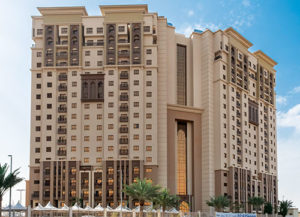
What the market wants is high selectivity and a high visible light to solar heat gain ratio. But in this region, due to the high intensity of natural sunlight, façade consultants opt for moderate light transmission while aiming to achieve the lowest possible solar heat gain. In the end, it is up to the architect and specific application (façades, skylights, atriums, etc.) But the glass industry is surely able to provide the best product.
Kachwala opines, harnessing the sun’s abundant light is a challenge. Avoiding glare, solar heat gain and uncontrolled illumination patterns are a designer’s aspiration. Day lighting is a powerful design element. Proper execution results in sustainable and energy efficient buildings.
Heat gain inside a building is a combination of direct & indirect solar radiation. Heat gain due to direct solar radiation is calculated as a summation of directly transmitted energy and absorbed energy re-emitted to the interiors.
Indirect solar radiation is the amount of heat transferred through a glass panel due to temperature imbalance between the inside and outside. Designers should study the sunpath diagram and define the placement of vision glass on buildings effectively. Specifying the right glazing can be critical to the success of a project. Innovative glass products that incorporate shading elements like mesh/glass fiber veils/louvers inside their construct can assist in effective light and heat management.
Performance Of Glass In Acoustic Insulation
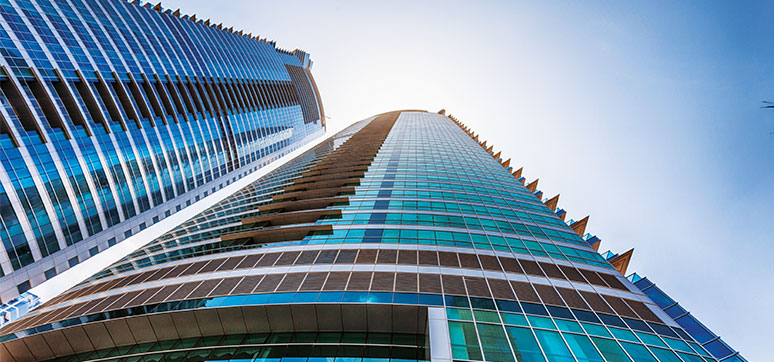 Al Fattan Towers, Marina, Dubai
Al Fattan Towers, Marina, Dubai
Baker says, acoustic insulation is a demand to provide a comfortable and healthy environment inside the building, which sometimes is a challenge. The glass by itself is a weak sound insulator, but the glass industry offers a wide range of solutions where the system of glass elastic membranes can provide a sound insulation index comparable to the one of a concrete wall.
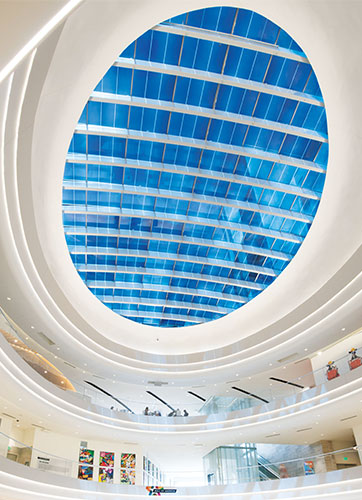
According to Garnier, glass offers very good acoustical insulation if it has the right combination.
Standard double glazing units have acoustical insulation level (Rw) of 31 to 32dB. But much higher levels can be achieved with the right combination of laminated glass panes with acoustical PVB interlayers and additional spacer thickness. For airports, acoustical insulation levels of 55dB can be achieved.
Pollmann says that while glass, especially double and triple glazing, has the benefit of air cavities, which acts as a natural sound insulator. We are also able to laminate glass with special purpose inter layers that significantly improve acoustic attenuation through the panels.
However, it is the entire system and structure of a building, namely glazing, frames, walls and even floors and ceiling intersections that need to be considered for optimal acoustic performance. Sound waves, similar to water, will travel along the path of least resistance. It is crucial that all construction elements and materials are of similar acoustic grade to achieve a good result.
Kachwala opines, with an increase in road/air traffic and greater settlement density, noise nuisance to the occupants has increased sharply. Consultants are incorporating noise mitigation in building design and actively specifying acoustic requirements for glazed façades.
Insulated glass units with a combination of laminated panes and different glass thicknesses help in improving sound control. Special sound control films in a laminate can improve sound insulation value by almost 5dB. Based on sound reduction requirements, the exact glass constructs can be achieved with required inner/outer pane laminates and the thickness of the insulated glass cavity.
Glass For Building Intelligent Futuristic Facades
Baker notes that the demand for glass for external façade keeps growing along with the increasing demand for using renewable energy. The next step in building intelligent futuristic façades to use façade glass as a transparent solar cells for generating the power. Once the architect selects the glass, it stays with him for the next 25-30 years with its static properties.
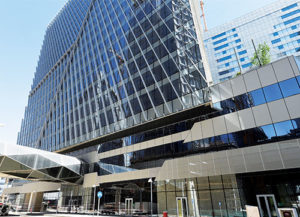
The future of the glass facade is in dynamic solutions, when the glass will smoothly adapt to the changing environment and the mood of the building occupant. Along with that, due to limited natural resources, large surfaces of glass facade should also serve as an efficient fully transparent renewable energy sources.
The possibilities offered by the dynamic electrochromic glass and glazing for future intelligent façades in enormous. Electrochromic glass can be controlled by light sensors that will determine the right amount of tinting to keep the interior of the building cooler. It means that these glazings can be connected to the internet directly or through the building management system.
The opportunities offered by connected façades are immense. The performance of the dynamic glass facade can be monitored to ensure the optimal use of daylight while limiting the amount of heat and glare. Connected dynamic glass facade open a completely new field of applications and possibilities that will be developed in the near future, says Garnier.
Pollmann believes that the next biggest thing will be glazing with the ability to passively generate energy. Currently available are products like Kromatix, an alternative façade cladding for non-vision panels and spandrel, which have integrated photovoltaic capabilities. Surely, the next evolutionary step should be fully transparent glazing elements that generate energy at high efficiencies and help buildings to achieve netzero carbon emission.
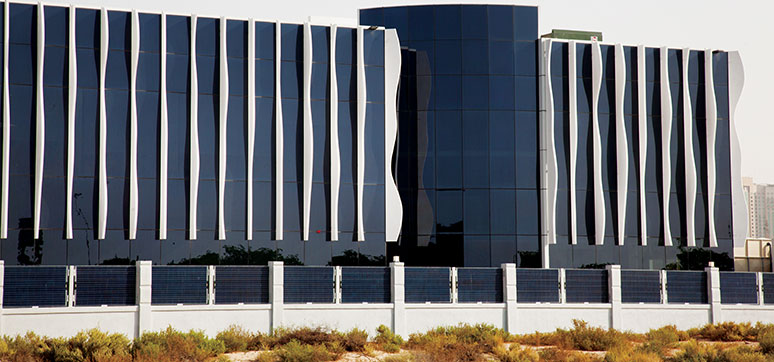 Chinse company HQ, Dubai Silicon Oasis, UAE
Chinse company HQ, Dubai Silicon Oasis, UAE
With the advent of technology, glass has become a responsive building element. It can respond to user inputs and a façade can be converted into a medium for stunning interactive media content.
By combining transparent qualities of glass and the media display properties of LED technology, developers can create a smart building that is interactive and excite people in whole new ways, points out Kachwala. Glass can respond to the climatic conductions and new dynamic glazing technologies have taken the front stage in fenestration.
Static shading devices limit the functionality and cause difficulty to maintain a comfortable environment at all times. Dynamic tinting glass technologies are now available that can adjust the light/heat instantly to suit user requirements. As sunlight intensifies or diminishes over time, this intelligent glass fine-tunes the shade to protect from solar glare and instantly regulate the temperature to bring optimal comfort, he further added.
Glass As Facade For Carbon-Neutral Buildings With Eco-Friendly Features
Sputter coating technology is able to provide eco-friendly glass solutions, helping to save the environment without compromising on living comfort. Visionary architecture requires high tech glass solutions matching the energy-saving requirements and constantly evolving eco-friendly features, says Baker.
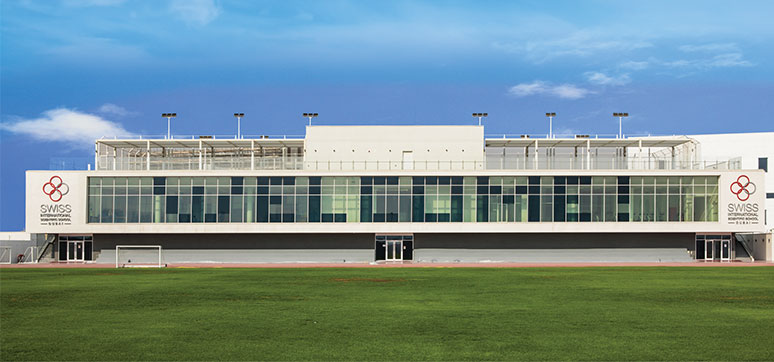 Welcome displayed on the dynamic façade at the SISD Sports Center, Dubai, UAE
Welcome displayed on the dynamic façade at the SISD Sports Center, Dubai, UAE
Indeed, dynamic electrochromic glass and glazings offer the best possible solution for energy efficient façades. Glass is no more a passive element that is installed in the façade. It is a connecting element that adapts constantly to the outside conditions and offers the best compromise for energy savings and net-zero energy buildings. In comparison to alternative glazing with or without blinds or shades, the use of electrochromic dynamic glass leads to a reduction in cooling energy use by 30% to 40%.
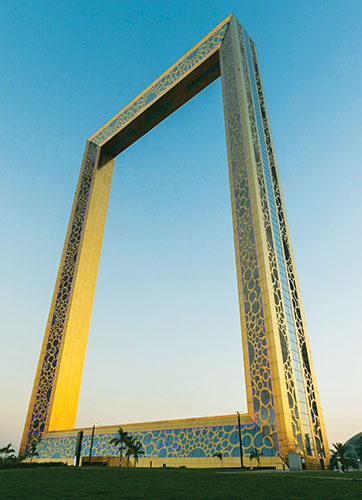
The LCA (Life Cycle Analysis) and EPD (Environmental Product Declaration) enable the user to know the environmental impacts of electrochromic glass during its life cycle. It is available to customers so that they can make objective comparisons of the carbon footprint of different materials integrated into the building’s façade. The LCA and EPD also help to analyse and reduce further our impacts and eco-innovate by creating new solutions and optimise current solutions with a reduced environmental impact, says Garnier.
Pollman says, luckily for the construction industry, technology and materials will never cease to evolve. What seemed to be the ultimate product ten years ago is old and outdated today. Continuous research and development is the only way to make sure that we stay on the right path to providing the best solutions for any given time in history. This is certainly true for architectural glazing – while we are on the right track, we have not reached the optimum in terms of heat gain vs. light transmission.
Glass has existed for long, replacing the other building materials. Over the years we have seen glass performance, improve considerably with the introduction of double and triple silver coatings.
Yes, these coatings are suitable for local conditions, however, we still have research on-going for further improvements, says Kachwala. In line with the UAE’s vision for carbon-neutral buildings, a variety of specialty glass products are being introduced in the market to enhance functionality. Glass constructs with U-value as low as 0.6 W/SqmK, are now available locally to prevent the transfer of heat from outside and reduce HVAC loads in the building, he added.
Solar Shading, Double-Skin Facades And Ventilated Facades
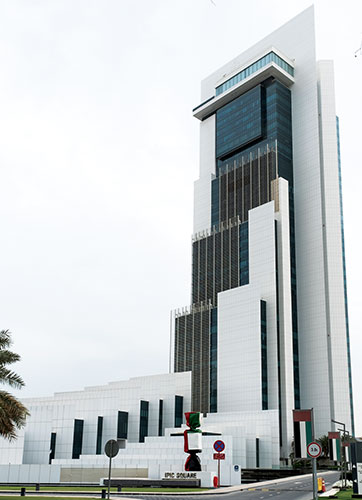
Baker says, as the glass becomes more important and frequently used material in the modern building, the façade engineers and glass manufacturers are working together to provide better awareness to the users and authorities. As of today, there are a lot of improvements in local regulations, it became obvious to consumers to use highly efficient glass in their facilities/buildings.
Garnier believes that the various stakeholders in the building industry, such as architects, designers, consultant, general contractors and façade contractors know these design possibilities such as ventilated façades and double skin façades very well.
There is a constant need for training and education, and professional associations have an important role to play together with the material suppliers. Education of the building end users and investors is a more challenging theme as there are very different levels of awareness amongst the public. I think it is the role of all the professionals in the value chain to inform and educate the public.
Architects and façade consultants have developed fantastic concepts. If by a consumer you mean the consultant, then the awareness level is very high. If you are referring to the occupant, the awareness level is generally low. Important is that we as a glass specialists and experts are able to guide, educate, support and assist architects and façade consultants in trying and simulating new concepts and help in selecting and designing the right type of product – as we continuously do, says Pollmann.
Consumers are well aware of solar shading requirements in façade. Local building regulations are strictly in place and ensure developers use the right glazing on their buildings. However, the use of double-skin façades and ventilated façades is not very common since the local building codes can be achieved with single skin façades. On some bespoke projects, developers aim for higher energy efficiency and LEED ratings, which may require the incorporation of double-skin façades, but such projects are limited, points out Kachwala.
Effect Of UAE Fire & Life Safety Code Of Practice – 2018
According to Baker, architects and engineers working together should remember about their social responsibilities, all their technical solutions have to be challenged for passive safety & security aspects. The Natural constant evolution of building codes towards fire & life safety is very important, but the entire construction industry has to improve a lot still.
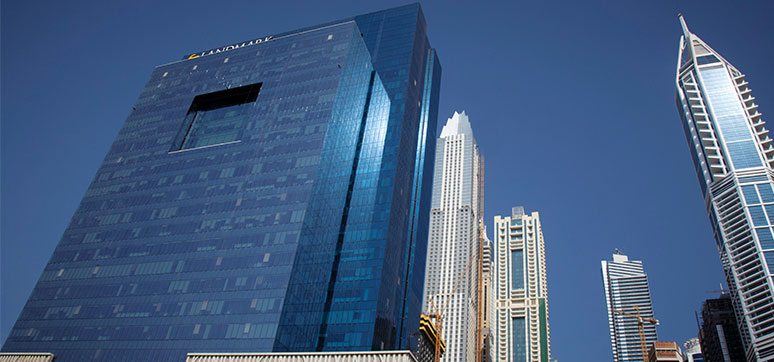 Landmark HQ, Dubai, UAE, by Arch Group
Landmark HQ, Dubai, UAE, by Arch Group
The UAE Fire & Life Safety Code requirements are aligned with the European and American regulations and aim to harmonise the global framework of regulations, which most leading glass manufacturers and processors are already complying with for a long time. However, the new code of practice eliminates interpretations of which exact standard is to be used in our region, points out Pollmann.
Kachwala believes that the UAE Life & Fire Safety code – 2018 is made for the betterment of the construction industry and it helps in achieving global safety standards. The process was conducted in all the fairness where industry experts from various fields were invited to present their views and ideas for establishing good codes. Being part of the committee, we were also able to contribute towards the Fire & Life Safety code and abide by its requirements.
Since it is being implemented, there is some uncertainty in the procedures and sometimes results in the stoppage of work, but I am hopeful the concerned authorities will define clear rules and guidelines to make the process easier for all, he adds.
Conclusion
Glass is used as an aesthetical material to beautify the look of the buildings. In the Middle East, the trend of glass buildings is not so new. There are several glass buildings in the region which are considered as the masterpieces. Glass offers several benefits to the buildings and its occupants. Earlier, the glass was not a perfect choice for the buildings in the regions with hot climatic conditions, but now technology has made it possible to make the glass a most preferable choice.
Top Stories
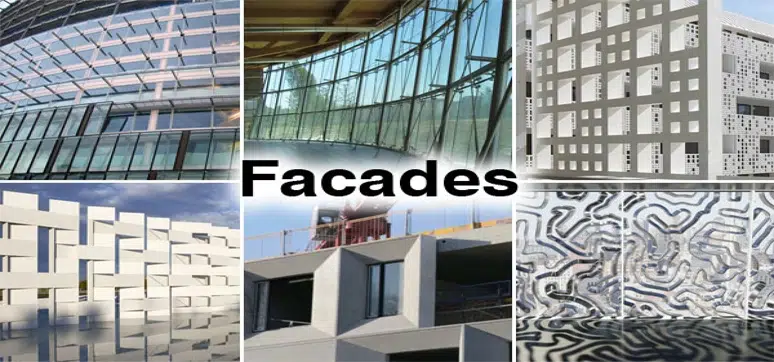
Façade Systems Market Size is Estimated to Reach USD 398.8 Billion by 2029
By: Abdul | April 16, 2024
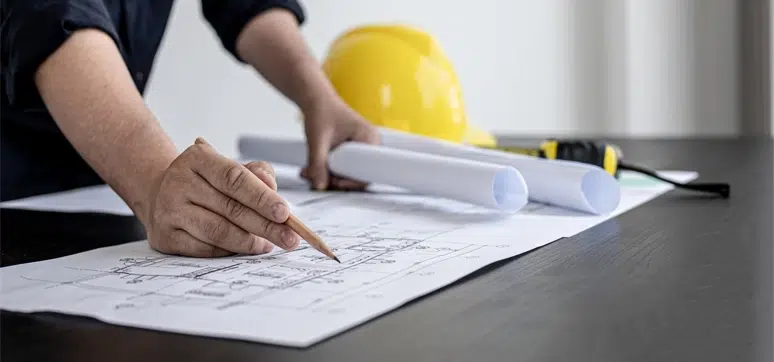
Improving Sustainability Alongside Fire Safety – Can We Deliver?
By: Abdul | April 16, 2024
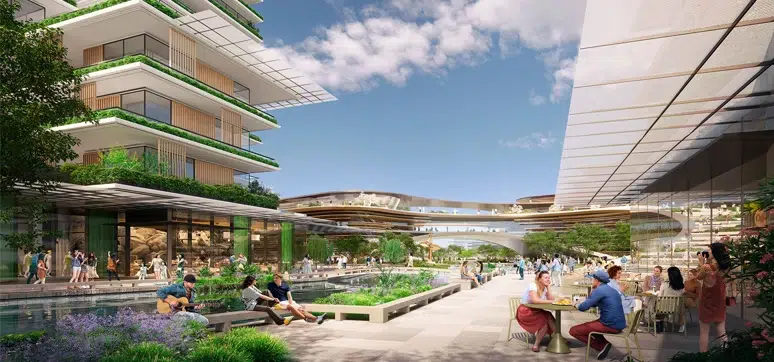
Foster + Partners Wins the Competition the New Xicen Science & Technology Centre
By: Abdul | April 9, 2024
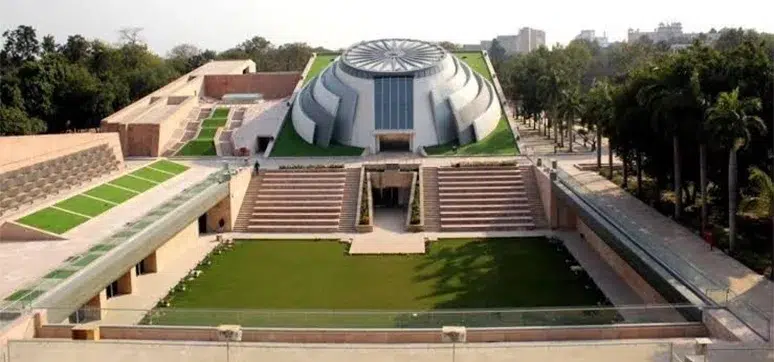
A Symbol of Architectural Brilliance & Cultural Significance
By: Abdul | April 8, 2024

